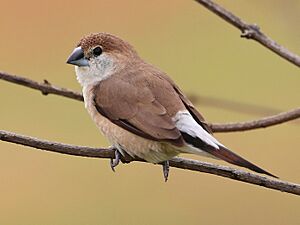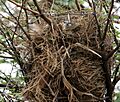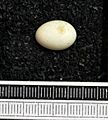Indian silverbill facts for kids
Quick facts for kids Indian silverbill |
|
|---|---|
 |
|
| Conservation status | |
| Scientific classification | |
| Genus: |
Euodice
|
| Species: |
malabarica
|
| Synonyms | |
|
|
The Indian silverbill, also called the white-throated munia, is a small bird. Its scientific name is Euodice malabarica. You can find this bird in the Indian Subcontinent and nearby areas. It's a type of finch that lives in dry places like the Middle East and India. These birds often live in small groups. They look for food in grassy areas and bushy lands. Sometimes, they are found in other parts of the world where people have brought them.
Contents
About the Indian Silverbill
Naming the Indian Silverbill
The Indian silverbill was first officially described in 1758. A Swedish scientist named Carl Linnaeus gave it the name Loxia malabarica. He was famous for creating the system we use today to name living things. The name "malabarica" comes from the Malabar Coast in India.
Later, scientists decided to place the Indian silverbill in a different group. This group is called Euodice. The Indian silverbill is very similar to the African silverbill. These two birds are the only ones in the Euodice group.
What Does the Indian Silverbill Look Like?
Adult Indian silverbills are about 11 to 11.5 centimeters long. That's about the length of your hand! They have a silver-grey beak shaped like a cone. Their top feathers are a light brown color. Their belly is white, and their sides are a light brown.
Their wings are dark, and their tail is black. The tail feathers get shorter from the middle outwards. This makes their tail look pointed. Young silverbills look a bit different. They have light brown bellies and shorter tails.
What Do They Eat?
Indian silverbills mainly eat seeds. They also sometimes eat small insects. You might even see them drinking nectar from flowers. For example, they like the flowers of Erythrina trees.
Where Do Indian Silverbills Live?
Indian silverbills like dry, open areas. They live in bushy lands and farms. Sometimes, they are found near water. You can find them in countries like Pakistan, Nepal, Bangladesh, India, Sri Lanka, Iran, and Israel.
People have also accidentally brought these birds to many other places. Now, they live in countries like Jordan, Kuwait, Oman, and Saudi Arabia. They have even been seen in the United States and southern France. Most Indian silverbills stay in one place. But some groups move around during different seasons.
Life and Habits of the Indian Silverbill
Social Life and Feeding
Indian silverbills are very social birds. They often live in groups of up to 60 birds. They look for food on the ground. They also search on low bushes and grass stems. As they search, they make soft chirping sounds to each other. They drink water by quickly sipping and swallowing. They eat many types of grass seeds. They will also eat seeds from farm crops.
Nesting and Reproduction
The breeding season for Indian silverbills changes depending on the area. In southern India, they nest in winter. In northern India, they nest after summer. Their nest is a messy ball of grass. It has an opening on the side. They usually build their nests in low bushes. Thorny Acacia trees are a common choice.
Sometimes, they use old nests made by other birds. They might even build their nest under the large nests of vultures or storks. Old nests are also used as sleeping places all year round. Female silverbills sometimes lay their eggs in another pair's nest.
A female silverbill usually lays 4 to 8 white eggs. Both parents take turns sitting on the eggs. This takes about 11 days. Sometimes, other birds help raise the young. This means more than two birds might be seen at a nest.
Images for kids











